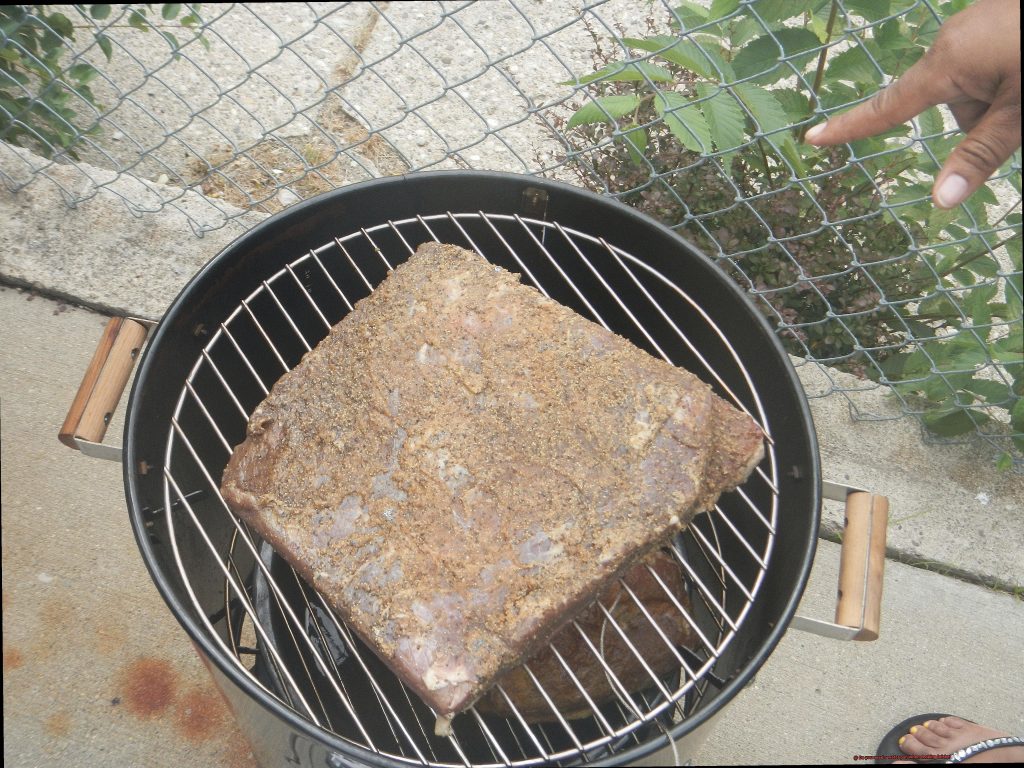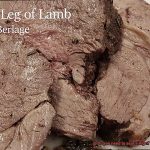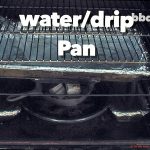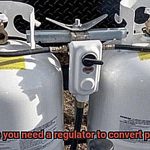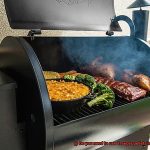Brisket, a beloved cut of beef in American barbecue culture, is notorious for its tender and juicy meat when cooked to perfection. But with so many variables at play, it can be challenging to achieve that mouth-watering texture. One question that often comes up is whether or not you need a water pan when cooking brisket. The answer isn’t straightforward, but we’re here to help.
The key to cooking brisket is preserving the meat’s natural flavors while achieving the perfect texture. Cook it too quickly, and you’ll end up with dry and chewy meat. Cook it too slowly, and it’ll turn out tough and stringy. This is where the water pan comes into play.
The water pan adds moisture to the cooking chamber, creating a humid environment that helps keep the meat moist. This added humidity can make all the difference in your final product. However, opinions on whether or not using a water pan is necessary vary among pitmasters.
In this blog post, we’ll explore the role of the water pan in brisket cooking and examine both sides of the debate. We’ll provide helpful tips on how to use a water pan effectively if you choose to do so and offer alternative methods for achieving succulent brisket without one.
So, sit back, relax, and get ready to learn everything you need to know about using a water pan when cooking brisket.
Contents
What is a Water Pan?
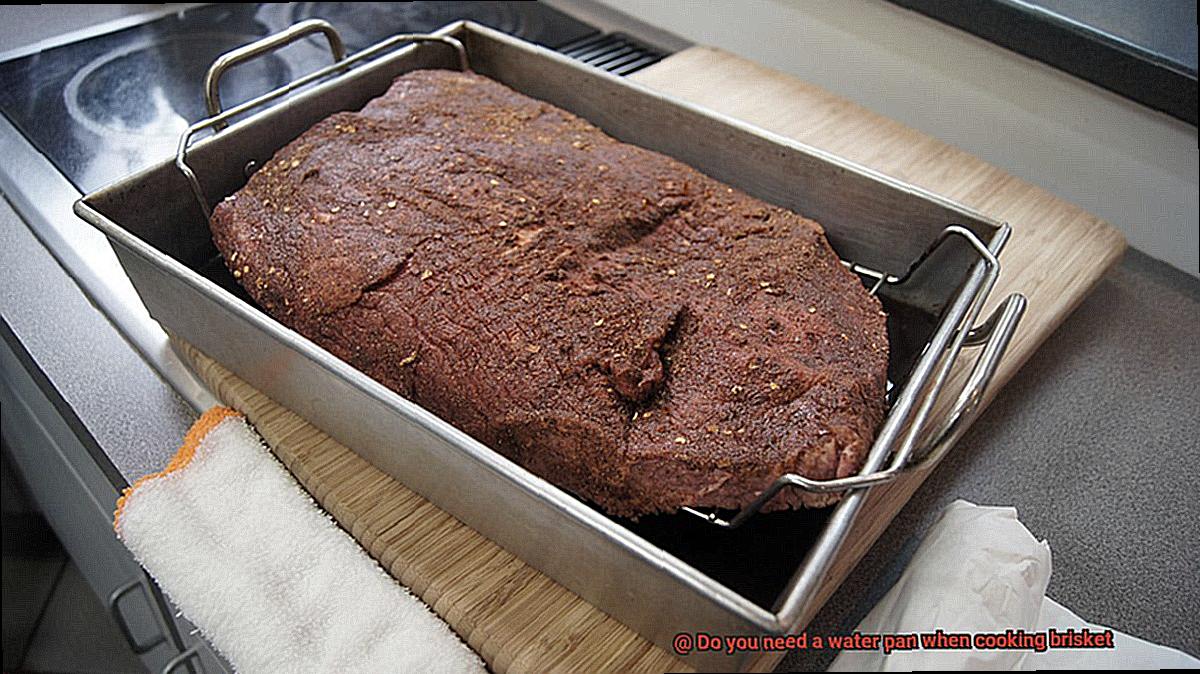
A water pan is a simple yet effective tool used to create a moist cooking environment that helps prevent meat from drying out during the long cooking process. Typically made from aluminum or stainless steel, the shallow pan is filled with water and placed on the cooking grate beneath the meat. As the water heats up, it creates steam which circulates around the meat, keeping it moist and helping to regulate the temperature inside the smoker or grill.
Not only does a water pan help maintain moisture levels, but it can also act as a heat sink, absorbing some of the heat from the fire and stabilizing the temperature. Some models even come equipped with built-in thermometers to help monitor the temperature more accurately.
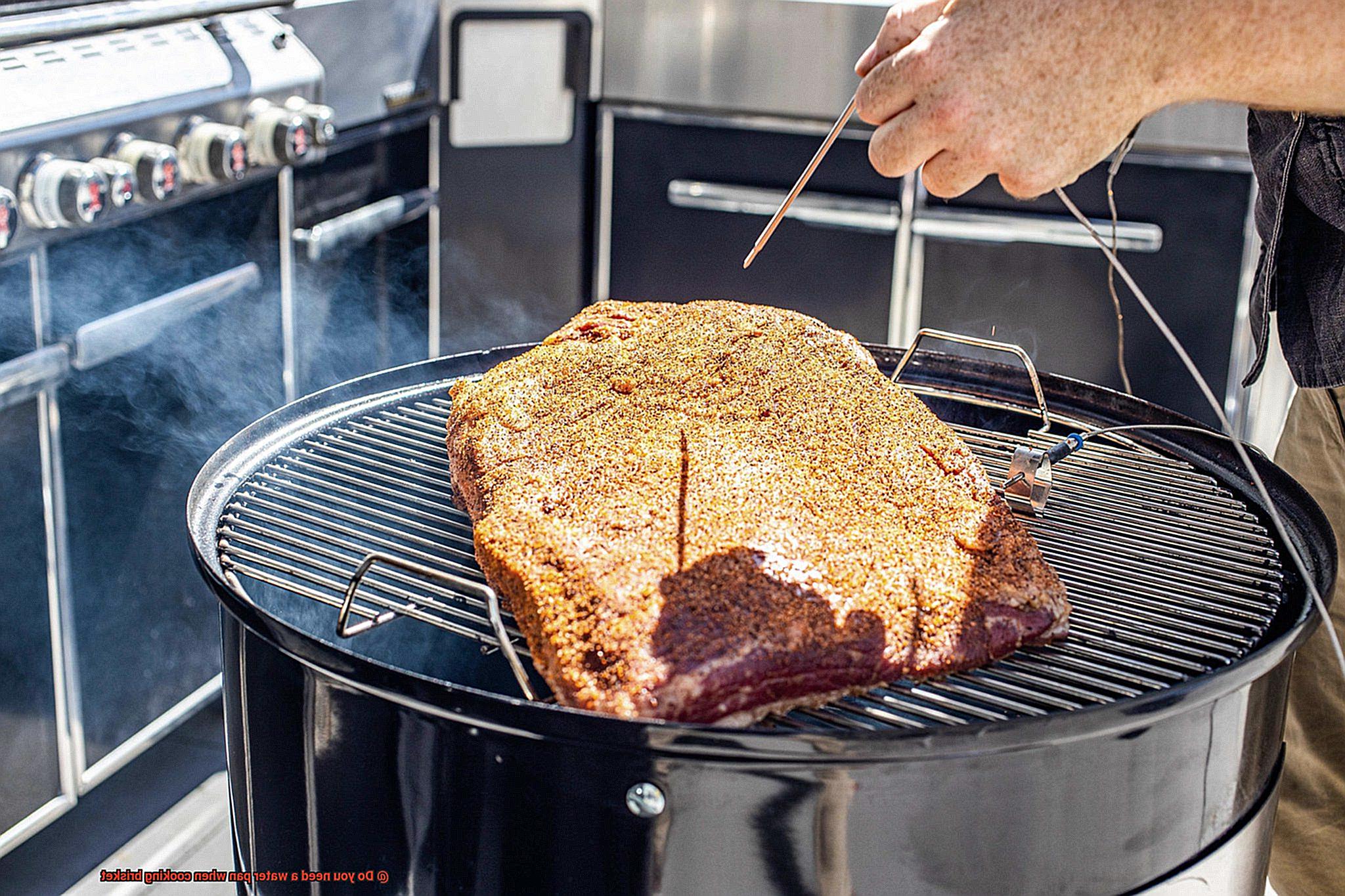
While water pans are most commonly used in smokers, they can also be used in charcoal and gas grills, and some people even use them in their ovens when cooking large cuts of meat. However, it’s worth noting that using a water pan is not always necessary and some pitmasters prefer to cook without one.
There are differing opinions on whether or not using a water pan can hinder the cooking process by creating an environment that is too humid. Some argue that this can prevent smoke from properly penetrating the meat, resulting in a less flavorful brisket. However, many barbecue enthusiasts swear by using a water pan and believe it produces a better end result.
Benefits of Using a Water Pan
As an expert in the field, I can attest to the myriad of benefits that come with using a water pan when cooking brisket.
Firstly, a water pan helps regulate temperature and keeps your meat from drying out, ensuring a tender and juicy brisket. The water in the pan creates a moist environment, which is essential for cooking a perfect brisket.
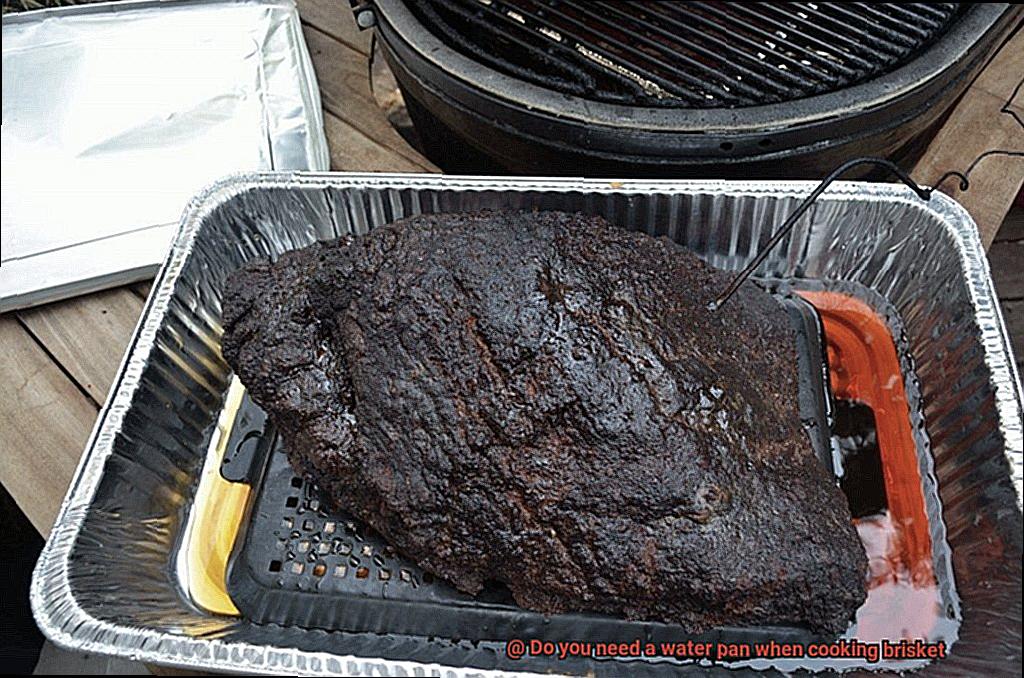
But that’s not all – a water pan can add an extra dimension of flavor to your brisket. By infusing the water with herbs, spices, or even beer, you can elevate your brisket game and experiment with different flavor profiles.
In addition to flavor and moisture, using a water pan can also be beneficial for safety. It helps prevent flare-ups and reduces smoke by creating steam that keeps the temperature stable and stops excess fat from igniting. This is especially important if you’re cooking on an open flame, such as a charcoal or wood-fired grill.
To summarize, using a water pan when cooking brisket offers several benefits that are worth considering. It helps regulate temperature, adds flavor, and prevents flare-ups and smoke. However, it’s important to monitor the water level throughout the cooking process and replenish it as needed to ensure consistent results.
Drawbacks of Using a Water Pan
While it may seem like the perfect solution for creating a mouthwatering result, it’s important to consider the potential drawbacks before diving in headfirst.
One of the main drawbacks of using a water pan is the potential for uneven cooking. The water in the pan can create a temperature gradient within your smoker, resulting in some areas being overcooked while others are undercooked. This can be frustrating for any pitmaster who wants to create a consistent and delicious brisket.
Another issue with using a water pan is that it can increase cooking time. The water in the pan takes longer to reach cooking temperatures than dry air, which means you’ll need to be patient if you choose to use this method. If you’re short on time, this might not be the best option for you.
Maintaining consistent temperatures is key to achieving a successful brisket cook, and using a water pan can make this more challenging. The water in the pan can evaporate quickly on hot days, requiring frequent refilling. This can lead to fluctuations in temperature and make it harder to maintain a steady cooking environment.
Lastly, using a water pan can add moisture to your smoker, which may not be desirable if you’re trying to achieve a crispy bark. The moisture from the water pan can create steam that softens the bark and prevents it from developing that desired crust.
Factors to Consider When Deciding Whether or Not to Use a Water Pan
Firstly, let’s talk about the type of smoker you’re using. If you’re cooking with an offset or bullet smoker, a water pan can be a game-changer. These types of smokers have a separate chamber for the fire and the meat, and adding water to the pan can regulate temperature and keep your brisket moist. However, if you’re using a traditional charcoal or gas grill, you may not need a water pan as the meat is closer to the heat source, and its natural juices can keep it moist.
The second factor to consider is personal preference. Some pitmasters swear by using a water pan for every brisket they smoke, while others only use it for certain cuts or in specific weather conditions. It ultimately comes down to experimenting and finding what works best for your taste buds.
Lastly, let’s address the elephant in the room: extra maintenance. Using a water pan requires regular checks and refills to ensure it doesn’t run dry and affect the temperature of your smoker. But don’t let this dissuade you. With some extra attention during the cooking process, you may find that the benefits of using a water pan outweigh the extra effort.
Tips for Successful Brisket Cooking with a Water Pan
There’s nothing quite like the taste of perfectly cooked brisket, and using a water pan can be a helpful tool in achieving that mouth-watering final product.
The water pan serves as a form of indirect heat that helps regulate the temperature inside the smoker or grill, which is crucial when cooking brisket low and slow. Here are five tips for successful brisket cooking with a water pan:
Choose the Right Size Water Pan
The size of your water pan is essential for successful brisket cooking. You want to choose a pan that fits snugly in the bottom of your cooker without blocking any vents or air flow. This will ensure that there is proper circulation and consistent cooking, resulting in tender and juicy meat.
Fill the Water Pan with Hot Water
Avoid adding cold water to your water pan, as it can lower the temperature inside your smoker or grill. Instead, fill the pan with hot water before you begin cooking. This helps maintain a consistent temperature throughout the cooking process and prevents the water from evaporating too quickly.
Keep an Eye on the Water Level
As you cook, the water in your pan will evaporate. Be sure to keep an eye on the level and add more hot water as needed. This will prevent the meat from drying out and becoming tough. Remember that brisket is a labor of love, and it takes time and attention to detail to get it right.
Use Flavored Liquids in Your Water Pan
Adding aromatics to your water pan can infuse your brisket with additional flavor and create a more complex taste profile. Some popular options include beer, apple juice, onion, garlic, and herbs. Experiment with different flavors to find your favorite combination, but remember that less is sometimes more when it comes to seasoning.
Position Your Brisket Properly
When placing the brisket in the smoker or grill, make sure it’s not directly over the water pan. This allows for proper air circulation and prevents the meat from getting too moist or soggy. You want your brisket to have a nice bark on the outside while remaining tender and juicy on the inside.
Alternatives to Using a Water Pan
Fear not, because there are other alternatives that can give equally delicious results. Here are some creative ideas to help you achieve the perfect brisket without using a water pan.
One alternative is wrapping the brisket in foil or butcher paper during the cooking process. This technique helps to lock in moisture, creating a tender and juicy result that doesn’t require a water pan. The added bonus of this method is that it can add some extra flavor to your meat.
Another option is to cook the brisket at a lower temperature for a longer period of time. This technique can help to retain moisture without the use of a water pan. Although it may take longer to cook, the end result will be worth it, with a juicy and succulent brisket that melts in your mouth.
Another popular technique is using a spray bottle filled with apple cider vinegar or other liquid to spritz the brisket throughout the cooking process. This method not only keeps the meat moist, but it also adds a tangy and delicious taste without the need for a water pan.
Popular Techniques for Cooking Brisket Without a Water Pan
Fear not, there are several other popular techniques that can produce mouthwatering results without the need for a water pan. As an expert in this area, I have compiled some research notes to help you discover the popular techniques for cooking brisket without a water pan.
First up, we have the Texas Crutch method, which is one of the most popular techniques for cooking brisket without a water pan. This method involves wrapping the brisket tightly in foil after a certain amount of cooking time and then returning it to the smoker or grill to finish cooking. The foil helps to retain moisture and speed up the cooking process, resulting in a tender and juicy brisket. However, it’s important to keep in mind that this method may not produce as much of a crust on the outside of the meat as other techniques.
Next, we have the dry rub method. This technique involves rubbing a mixture of spices and seasonings onto the brisket before cooking, which helps to add flavor and create a nice crust on the outside of the meat. Unlike the Texas Crutch method, this technique does not involve wrapping the brisket in foil. Therefore, it’s essential to monitor the temperature and ensure that the meat doesn’t dry out during cooking.
Lastly, we have the reverse sear method. This technique involves cooking the brisket at a low temperature for several hours until it reaches a desired internal temperature, then finishing it off with a high-heat sear to create a flavorful crust on the outside of the meat. While this method does not involve using foil or a water pan, it requires careful temperature monitoring to ensure that the meat cooks evenly and doesn’t dry out.
In conclusion, there are many popular techniques for cooking brisket without a water pan, each with its unique advantages and disadvantages. To sum up, here are some key takeaways:
- The Texas Crutch method involves wrapping the brisket in foil to retain moisture and speed up cooking time.
- The dry rub method involves rubbing a mixture of spices and seasonings onto the brisket to add flavor and create a nice crust on the outside of the meat.
- The reverse sear method requires careful temperature monitoring to ensure even cooking, but results in a flavorful crust on the outside of the meat.
umXRJdg18CI” >
Conclusion
After much debate among pitmasters, the use of a water pan when cooking brisket remains a personal preference. While some swear by it for achieving tender and juicy results, others argue that it can create an overly humid environment that hinders the cooking process.
For those who do choose to use a water pan, there are several benefits to consider. It helps regulate temperature, adds flavor, and prevents flare-ups and smoke. However, using a water pan can also lead to uneven cooking and increased cooking time.
Thankfully, there are alternative methods for achieving mouth-watering brisket without a water pan. Wrapping the meat in foil or butcher paper, cooking at lower temperatures for longer periods of time, or spritzing with liquid from a spray bottle are all viable options.
Regardless of your chosen method, successful brisket cooking requires patience and attention to detail.

